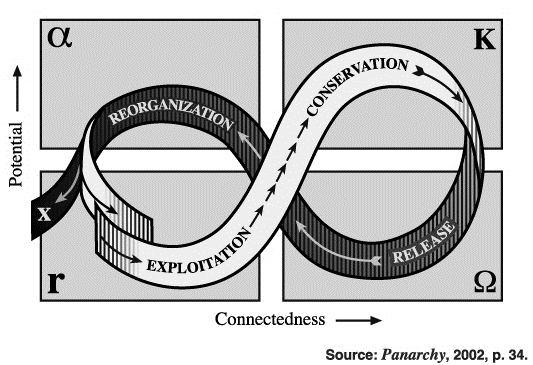I re-read Panarchy a while back and it’s even better the second time around! While I have pages of notes, thought I’d share three areas where it has influenced my practice.
- Revised our description of change. Fresh off teaching two week-long certificate courses, visions of change are dancing in my head. We introduce four aspects of change, dealing with sources, rates, levels, and time horizon. I think it’s time to add a fifth: cycles, drawing on the Adaptive Cycle notion at the heart of Panarchy. [I’m not quite sure if “cycles” is the right descriptor, it will have to do as a placeholder.]
Here’s the graphic of the adaptive cycle.
(R) Exploitation: rapid colonization of recently disturbed areas
(K) Conservation: sustained plateau or maximum population that is maintained
(Ώ) Release: creative destruction, e.g., in nature by fires, droughts, pests or intense pulses of grazing
(α) Reorganization: processes minimize nutrient loss so they become available for next exploitation
In business terms, exploitation is a period of growth and competition among entrepreneurs and survivors previous cycles; in conservation, the winners consolidate and then maintain the existing order; in release the established order breaks down and uncertainty increases; and in reorganization new players and alternatives emerge.
2. Rethink the analysis of “drivers.” Panarchy observes that ecosystems are comprised of fast and slow processes operating at different scales. Assuming that a domain or topic we are forecasting is an ecosystem, the “fast and slow at different scales” strikes me as particularly relevant to the phase in which we identify “drivers.” For practical purposes many times we simply consider drivers on equal terms. Yet, clearly they are part of systems moving at a different pace and having different reach or scope. There are fast-moving and slow-moving drivers with different scope. A challenge then, is how to operationalize these differences in “rate” and “scope?”
3. A new economic system should target adaptive capacity rather than steady state. A key notion of Panarchy is that adaptive cycles are nested in a hierarchy across time and space. Basically, there are many adaptive cycles, with different scopes and different time cycles, operating simultaneously. So, there are small-scale systems changing rapidly within large-scale systems changing slowly, multiply by “many” and note they are all interacting with one another at different levels, and you have a panarchy.
Fast-changing levels invent, experiment and test (learn) while the slower levels stabilize and conserve (continuity). So, the interaction between cycles in a panarchy combines learning with continuity. That clarifies the meaning of sustainable development: sustainability is the capacity to create, test, and maintain adaptive ability; development is the process of creating, testing, and maintaining opportunity.
I had been using the term “steady-state” to describe the goal of a transformed economic system, which I’ve been calling the Soft Path. Well, not exactly. Panarchy points out that many efforts to “fix” natural systems shoot for a steady-state or equilibrium, but this misses the fact that the nature is continuously changing. The goal is not to achieve and maintain steady-state, but rather a system that is capable of adapting along with the continuously changing system. Thus, a transformative economic system is one capable of being adaptive.
These are just three insights that I was able to immediately apply. I have several more pages of notes to digest. Andy Hines

Hi Andy,
Nice reflections. I appreciated them.
I’ve been thinking about Panarchy for a while as well. I got frustrated with the relatively poor quality graphics online for the idea, so I made my own.
Feel free to use them if you’d like!
Drawing a Better Panarchy Diagram
http://news.noahraford.com/?p=648
All my best,
Noah
thanks so much, Noah! Hey readers, very much worth the visit to Noah’s site. Great stuff!
Andy – thanks for sharing!! I’ve just ordered the book and very much looking forward to reading it.
You know I’m a strong believer in cycles and systems – really glad you posted this.
Talk soon.
Carlos